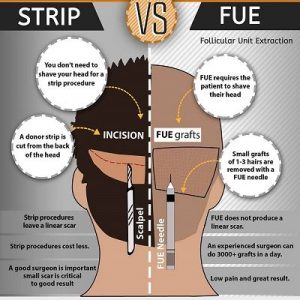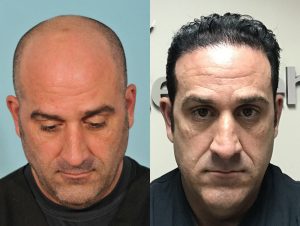FUE vs FUT | Which has greater success rate?
Hair transplants may be a great way to feel younger and more confident, but they don’t come inexpensive.
What’s more, US, UK, Canadian, Australian, and EU healthcare plans, whether they are private or government-run, typically won’t consider hair transplants “medically necessary” and thus won’t cover them.

There are exceptions (notably medical conditions such as chemo or reconstructive surgery after an accident) but otherwise, hair transplants are expensive, which means the stakes for success or failure are incredibly high.
You don’t want all those hundreds or thousands of dollars or pounds to be for nothing, which makes it that much more important to find procedures that maximize your chances for success and minimize those of failure.
There are two distinct types of hair transplants, Follicular Unit Extraction (FUE) and Follicular Unit Transplantation (FUT).
Between the two of them, FUT tends to offer a greater yield of hair, while FUE tends to leave fewer seams and is thus easier to make appear “natural.”
Both have their pros and cons, but neither will count for much if the grafts themselves do not survive long.
With that in mind, let’s compare the survival rates for FUE and FUT along with some graft care strategies to help you decide what you can do to maximize your chances of getting the maximum value for your investment.
Hair Transplant Success and Failure [actual numbers]
One of the biggest quandaries facing those looking for a hair transplant is the fact that there is a huge average range of effectiveness.
While they tend to be more effective than over-the-counter treatments, there are several factors mitigating that success, ranging from the quality and type of the treatment to the skill of the surgeon to the region on your body from which the hair grafts are taken.
Success rates average out to between 60% and 80%, though as we’ll see, that can be considerably higher for certain techniques.
However, anywhere from 10% to 90% of transplanted follicles can fall out.
The big caveat with that, however, is that in a successful transplant these fall out as new, natural follicles grow in to replace them.
Still, it’s a number to be aware of when making short-term plans after a transplant.
Possible reasons for hair transplant failure
Potential reasons for a failed transplant include:
- Poor Surgical skills: One of the big reasons you’ll see a huge range of prices for hair transplants is the fact that there is an enormous variation in the skill level of surgeons all over the world.
While hair transplants aren’t inexpensive and you always want to save money, the old adage is also true – you get what you pay for.
Chances are, if a treatment sounds too inexpensive and too good to be true, chances are it is.
Trained surgeons with years or even decades of experience will charge accordingly, and those are the experts you want in charge of reviving your hairline.
- Poor Post-Op Care: We’ll get into this more later, but suffice it to say that even a good surgeon’s work can be spoiled if you don’t take care of the newly-implanted hair follicles properly.
- Not Getting the Right Treatment: A big misconception about FUE, FUT, and other hair transplant methods is that some are “better” than others. While there are distinct advantages and disadvantages to these methods, they each have their place.
However, not every treatment is suitable for every scalp condition.
If you try and force a treatment that isn’t ideal for your scalp, it’ll be like trying to force a square peg into a round hole – a bad fit, and you shouldn’t be surprised if it doesn’t stick.
You must pick the right hair transplant technique for you, not what is popular,
- Poor Graft Handling: If the graft in question isn’t handled properly, it can dry out.
- Genetics: Studies have shown that autosomal dominant genetic linkage is one of the most common causes of hair loss.
FUE Versus FUT Survival Rate
Another good aspect of FUE is the fact that it features a high graft survival rate, with the average hovering somewhere around 90%.
For FUT, however, that rate can climb even higher to 95% to 98%.
However, as mentioned above, not every treatment is suitable for every patient, and those rates are averages.

You will also notice that both of those figures are well above the 60% to 80% success rate mentioned above.
While that overall average is dragged down in part by subpar and outdated methods with higher failure rates, it may also be lowered by patients getting treatments with otherwise-high success rates that are not suitable for their scalps.
You’ll thus want to talk with your surgeon and listen to their recommendations as to which method is best for you.
The importance of that suggestion again underlines the essential role skilled surgeons play in the process.
Post-Op Considerations
Another huge consideration in determining whether your surgery is a success or failure is, as mentioned, how attentive you are to your scalp’s post-op needs.

Good post-op scalp caretaking includes:
- Avoiding strenuous work for at least one week after the transplant, this includes running and lifting heavy weights
- Avoiding saunas, sun baths, and other sources of extreme heat for at least three weeks
- Avoiding sexual activity for at least one week
- Avoiding head coverings for at least a week so as to let your new hair follicles breathe
- Washing your hair gently after the third day; take care not to apply too much pressure to the new follicles
- Sleeping with a neck pillow for the first five to seven nights after the procedure; ideally, your head should be at a 45° angle, and kept elevated so as to avoid swelling
- Eating healthy, with plenty of veggies, natural oils, and Vitamin B; alcohol, coffee, and fast food should be avoided in the first days or weeks after the procedure
Given the high stakes, you want to do everything in your power to increase the already-good chances of your hair transplant taking root and giving you the full, natural-looking head of hair you want and deserve.

Pharmacist with special interest in hair loss and hair transplantation.
Read my book on hair transplants in Turkey on Amazon:
https://track.more-info.co.uk/amazon/authorprofile

